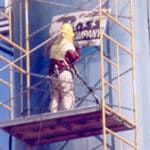Structural Steel Painting
Steel is a prime constituent in the construction of buildings, as it’s a strong and sturdy support, making structural steel painting an important consideration when planning for building maintenance. These days, as most buildings are centrally air-conditioned where the humidity level is maintained at ranges that are not detrimental to steel life, in most cases, when building maintenance is done, the steel structures don’t really need to be painted. This point should be taken into consideration, as unnecessary painting of the steel structures only leads to unwanted expenses if it wasn’t required in the first place. In case, it is decided that structural steel painting is required, then all steel joints and beams should be examined to determine which out of them need the paint job. In the case of steel joints, unexposed open steel joints, i.e., steel joints that are hidden in a corner or covered with fire-resistant materials, do not need to be re-painted as they are already protected from the environment.
The best way to paint open steel joints is by immersion, in which the steel joint is immersed in the paint, ensuring uniform coating of the joint. This is best possible when the standard paint color and types are needed, as in the case of special paints, immersion is avoided, and spray painting is done, which leads to overspray, which causes cleaning problems later on. Before the painting process can be carried out, certain steps need to be performed to ensure proper and uniform coating of the paint, which also ensures longer paint life. One of these steps is surface steel preparation, in which all joints and welded areas are checked for defects, all sharp edges are ground to create smooth surfaces, and noncontinuous welding lines are filled again by welding.
Once surface preparation has been done, the next step is the surface steel treatment, wherein the surface of the steel is treated or cleaned. This is an important step, but it is imperative that all dirt particles, dust, impurities, etc., be removed from the surface of the steel and painted to ensure smooth application of the paint. This includes the removal of oil and grease from the surface of the structure by using suitable methods. This can be done either by the use of solvents or by sandblasting the structural steel.
As mentioned before, as most buildings these days are temperature and humidity-controlled, in certain cases, structural steel painting is done primarily for the purpose of appearance or to improve the aesthetics of a building, and corrosion is not a main concern. In such cases, only a single coat of paint is required as the steel is already protected from the elements. Sometimes, the steel structure already has a primary or base coat that has been applied by the manufacturer for the purpose of protection. In such situations, when applying the secondary coat, which is the one that gives color to the structure, care should be taken to ensure compatibility between the primary coat and the top coat. Generally steel structures in a building are not isolated or only surrounded by other steel structures.
They may have concrete wood or other construction materials in the adjacent areas, which give rise to the need for care to be taken during the painting of the steel structures to ensure that there is no over-spray or paint splatter on the adjacent structures. For example, in the case of perimeter steel structures surrounded by concrete that have been left unpainted, there may be rust runoff on the concrete due to the steel being exposed to the environment and its effects. In such cases, a one-coat paint can be used, which is meant as a temporary short-term solution and needs to be reapplied from time to time depending on the surrounding factors like weather, exposure, etc.
Steelwork that will not be left exposed and unprotected, like that which will be enclosed in concrete or covered with fire-resistant material, does not need to be re-painted/painted at all, as it is already protected from external factors. However, in case a base coat of paint has already been applied prior to encasement, then there is no need for the paint to be removed as it only serves to work as an extra layer of protection to increase the life of steel. But, care has to be taken to ensure that the paint that has been applied to the steel does not, in any way, hamper the bonding of the steel with the applied material, like concrete. In such a situation, the paint has to be removed because it is important that there be proper bonding between the steel and concrete, as it directly affects the strength of the structure.













